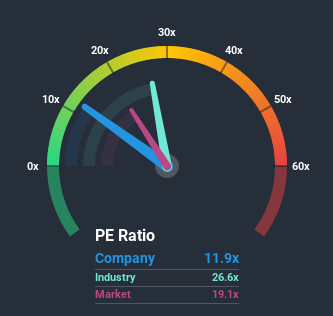Why Investors Shouldn't Be Surprised By Raymond James Financial, Inc.'s (NYSE:RJF) Low P/E

Raymond James Financial, Inc.'s (NYSE:RJF) price-to-earnings (or "P/E") ratio of 11.9x might make it look like a buy right now compared to the market in the United States, where around half of the companies have P/E ratios above 20x and even P/E's above 38x are quite common. Nonetheless, we'd need to dig a little deeper to determine if there is a rational basis for the reduced P/E.
With earnings that are retreating more than the market's of late, Raymond James Financial has been very sluggish. The P/E is probably low because investors think this poor earnings performance isn't going to improve at all. You'd much rather the company wasn't bleeding earnings if you still believe in the business. If not, then existing shareholders will probably struggle to get excited about the future direction of the share price.
View our latest analysis for Raymond James Financial
Keen to find out how analysts think Raymond James Financial's future stacks up against the industry? In that case, our free report is a great place to start.
How Is Raymond James Financial's Growth Trending?
In order to justify its P/E ratio, Raymond James Financial would need to produce sluggish growth that's trailing the market.
If we review the last year of earnings, dishearteningly the company's profits fell to the tune of 13%. However, a few very strong years before that means that it was still able to grow EPS by an impressive 47% in total over the last three years. So we can start by confirming that the company has generally done a very good job of growing earnings over that time, even though it had some hiccups along the way.
Turning to the outlook, the next three years should generate growth of 4.8% each year as estimated by the nine analysts watching the company. That's shaping up to be materially lower than the 14% per annum growth forecast for the broader market.
In light of this, it's understandable that Raymond James Financial's P/E sits below the majority of other companies. It seems most investors are expecting to see limited future growth and are only willing to pay a reduced amount for the stock.
The Key Takeaway
It's argued the price-to-earnings ratio is an inferior measure of value within certain industries, but it can be a powerful business sentiment indicator.
We've established that Raymond James Financial maintains its low P/E on the weakness of its forecast growth being lower than the wider market, as expected. Right now shareholders are accepting the low P/E as they concede future earnings probably won't provide any pleasant surprises. Unless these conditions improve, they will continue to form a barrier for the share price around these levels.
You always need to take note of risks, for example - Raymond James Financial has 2 warning signs we think you should be aware of.
Of course, you might also be able to find a better stock than Raymond James Financial. So you may wish to see this free collection of other companies that sit on P/E's below 20x and have grown earnings strongly.
This article by Simply Wall St is general in nature. It does not constitute a recommendation to buy or sell any stock, and does not take account of your objectives, or your financial situation. We aim to bring you long-term focused analysis driven by fundamental data. Note that our analysis may not factor in the latest price-sensitive company announcements or qualitative material. Simply Wall St has no position in any stocks mentioned.
Have feedback on this article? Concerned about the content? Get in touch with us directly. Alternatively, email editorial-team@simplywallst.com.

 Yahoo News
Yahoo News 

